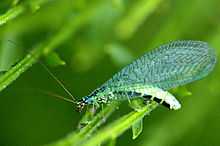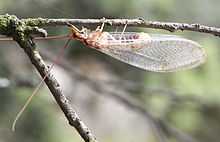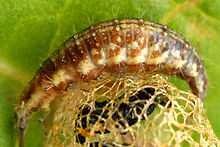Chrysopinae
From Wikipedia, the free encyclopedia
| Chrysopinae | |
|---|---|
 | |
| Chrysopa perla (Chrysopini) | |
| Scientific classification | |
| Kingdom: | Animalia |
| Phylum: | Arthropoda |
| Class: | Insecta |
| Order: | Neuroptera |
| Family: | Chrysopidae |
| Subfamily: | Chrysopinae Esben-Petersen, 1918 |
| Diversity | |
| About 60 genera | |
Chrysopinae is a subfamily of green lacewings in the insect family Chrysopidae in the order Neuroptera. They are the nominate taxon and largest member of the green lacewing family (Chrysopidae), containing about 60 genera.
Members of the genus Chrysoperla and the genus Chrysopa in this subfamily are common in Europe and North America. Their larvae are predatory and feed on aphids; some of these species have been used in biological pest control, as has the Australian Mallada signatus.[1]
Genera
The genera are divided into four tribes:[2]

Italochrysa italica (Belonopterygini)

Chrysoperla larva (Chrysopini)
|
Ankylopterygini Navas, 1910
Belonopterygini
Leucochrysini
|
Chrysopini
|
Some Chrysopidae are of presently unknown relationships. Of these genera, some are suspected to be Chrysopinae, namely:
- Tibetochrysa Yang, 1988
- Xanthochrysa Yang & Yang, 1991
- Yunchrysopa Yang & Wang, 1994
Footnotes
References
| Wikimedia Commons has media related to Chrysopinae. |
| Wikispecies has information related to: Chrysopinae |
- New, T. R. (2002): Prospects for extending the use of Australian lacewings in biological control. Acta Zoologica Academiae Scientiarum Hungaricae 48(Supplement 2): 209–216. PDF fulltext
- Shelton, Anthony [2011]: Biological Control: A Guide to Natural Enemies in North America – Chrysoperla (= Chrysopa) carnea, C. rufilabris (Neuroptera: Chrysopidae). Retrieved 2011-FEB-02.
This article is issued from Wikipedia. The text is available under the Creative Commons Attribution/Share Alike; additional terms may apply for the media files.